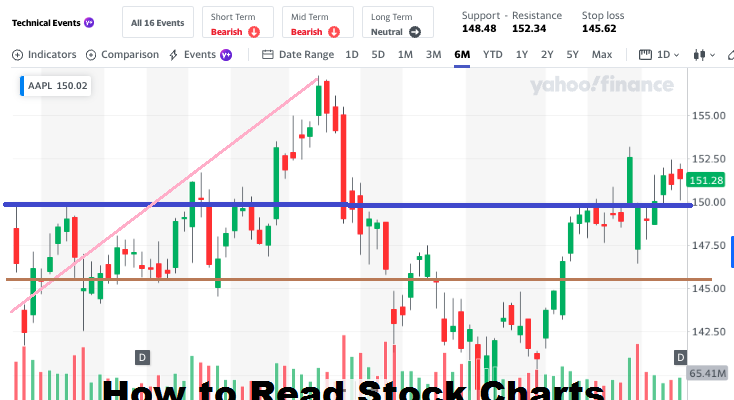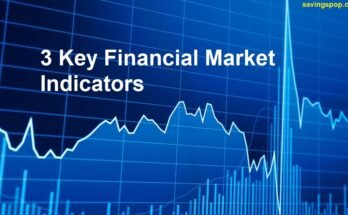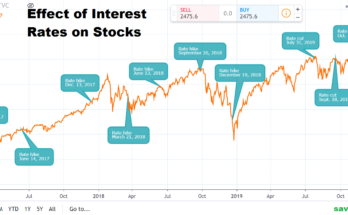Learning how to read stock charts can be clean and a laugh! To begin with, research the basics: the inventory charge is displayed on the y-axis, and time is displayed on the x-axis. The reason candlestick charts are so popular is they display a number of information. The commencing, closing, high, and coffee charges for a given time period are displayed on each candlestick. Red candles characterize a decrease in rate, even as inexperienced candles show an increase in charge. To assist you forecast future pricing, search for styles and traits, which includes upward or downward movements. You’ll get more adept at identifying those styles and selecting wisely on the subject of investing with experience.
How to Read Stock Charts
Understanding inventory charts is critical for traders and buyers. Stock charts display how a stock’s fee has visually modified through the years. They help analyze marketplace traits and make clever choices. This guide teaches you the basics: How to examine stock charts, types of charts, styles to look at for, and technical signs. By studying these charts, you could spot developments and predict destiny fee actions. This expertise is crucial for buying stocks at the proper time and selling them when the price is excessive. In precis, inventory charts are effective tools that supply perception right into a inventory’s beyond performance and help forecast its destiny path in the marketplace.
Understanding Chart Components
How to read stock charts involves knowing their key components, which help investors analyze price movements and trading activity over time.
Axes:
Stock charts have two main axes:
- X-Axis (Horizontal): This axis represents time, ranging from short periods like minutes to longer ones such as years. It helps investors track how a stock’s price has changed over different time frames.
- Y-Axis (Vertical): This axis represents the stock price. It shows the price levels at which the stock has traded during the specified period on the chart. The Y-axis helps investors understand price trends and levels of support and resistance.
Volume Bars:
Volume bars provide insights into trading activity:
- These bars illustrate the number of shares traded over a specific time interval, such as a day, week, or month.
- High volume indicates strong interest in the stock. It suggests that many investors are actively buying or selling shares, potentially influencing future price movements.
- Conversely, low volume indicates weaker interest. It may suggest that fewer investors are trading the stock, which could mean less volatility or less significant price movements.
For example, a chart with high-volume bars during a price increase might indicate strong buying interest, reinforcing the upward trend. On the other hand, a price decrease accompanied by high volume might suggest selling pressure and potential future declines.
OHLC (Open, High, Low, Close)
OHLC (Open, High, Low, Close) are key data points used in financial markets:
- Open: This is the price of a stock when trading begins for a given period, like a day.
- High: It’s the highest price the stock reaches during that period.
- Low: This is the lowest price the stock drops to during the same period.
- Close: It marks the price of the stock when trading ends for that period.
Together, these points provide a snapshot of how a stock’s price behaved throughout a specific time frame. Traders and analysts use OHLC data to understand price trends, and volatility, and make decisions about buying or selling stocks. It’s a fundamental tool in technical analysis and helps in predicting future price movements based on historical patterns.
Types of Stock Charts
Stock charts are visual representations that display the price movements of a stock over time, helping traders and investors analyze trends and make decisions. There are various frequently used stock chart types:
1. Line Charts:
Line charts are the most primary type. They plot the remaining costs of a inventory over a distinct time period, which include an afternoon, week, month, orf 12 months. Each last rate is represented via a dot, and these dots are linked with a line. Line charts are simple and offer a quick assessment of ways a stock has done through the years, displaying whether or not the price has typically long past up, down, or stayed particularly strong.
2. Bar Charts:
Bar charts offer more certain facts as compared to line charts. Each bar on a bar chart represents one period (e.g., an afternoon or a week) of buying and selling. The top of the bar represents the very best price reached for the duration of that length, and the lowest represents the bottom charge. Horizontal traces on the sides of the bar imply the opening (left aspect) and last (proper side) fees. Bar charts offer a visual depiction of fee levels and the path of fee motion within each length.
3. Candlestick Charts:
Candlestick charts are broadly used by buyers due to their ability to visually represent rate movements effectively. Each candlestick on the chart represents the open, high, low, and near expenses for a particular duration (e.g., an afternoon or every week). The frame of the candlestick indicates the charge range between the open and close prices: a filled (or stable) frame means the near became decrease than the open, even as an empty (or hollow) frame method the near was higher than the open. The traces above and underneath the body, known as wicks or shadows, show the best and lowest fees reached all through that duration. Candlestick charts help investors fast examine whether prices are rising (bullish) or falling (bearish) and the power of price actions.
In summary, each type of stock chart-line, bar, and candlestick serves its cause of providing distinct levels of detail and visible facts approximately stock charge actions. Line charts are sincere for quick evaluation, bar charts offer more exact rate facts for every length, and candlestick charts provide insights into rate trends and market sentiment with their specific visual illustration of charge stages and fee route.
Key Chart Patterns
Key chart patterns and trend lines are tools used in technical analysis to understand price movements in financial markets.
Trend Lines:
Trend lines are lines drawn on a price chart to show the direction of a stock’s price movement. An upward trend line connects the lows of a stock, suggesting a bullish trend where prices are generally rising. A downward trend line connects the highs, indicating a bearish trend where prices are generally falling.
Support and Resistance Levels:
Support and resistance levels are key prices on a chart where a stock tends to stop and reverse its direction.
- Support Level: This is a price level where the stock often finds buying interest, causing it to bounce back up. It indicates that buyers are stepping in, preventing further decline.
- Resistance Level: This is a price level where the stock encounters selling pressure, causing it to reverse its upward movement. It indicates that sellers are active, preventing further rise.
Common Chart Patterns:
Chart styles are unique formations that appear on price charts, signaling potential trend reversals or continuations.
- Head and Shoulders Pattern: This pattern includes three peaks, with the middle top (head) being higher than the alternative (shoulders). It suggests a potential trend reversal from bullish to bearish.
- Double Top/Bottom: A double pinnacle paperwork when the fee reaches a peak twice at a comparable degree, indicating a potential reversal from an uptrend. Conversely, a double bottom bureaucracy at a low charge stage two times, suggesting a ability reversal from a downtrend.
- Triangles (Ascending, Descending, Symmetrical): These patterns are continuation styles that advise the inventory may also preserve its contemporary fashion after a period of consolidation. An ascending triangle indicates a flat top with growing lows, a descending triangle has a flat bottom with descending highs, and a symmetrical triangle has each growing lows and descending highs.
By figuring out those styles and fashion lines, buyers and buyers aim to expect future price actions and make informed decisions approximately buying or promoting stocks. Technical analysis relies on the notion that past price actions can help predict future price movements. However, it isn’t foolproof, and factors such as market news and economic data also affect stock prices.
Technical Indicators
Technical indicators are tools used by traders and analysts to interpret stock price movements and identify potential trends in financial markets. Here’s a breakdown of some commonly used technical indicators:
Moving Averages:
Moving averages (MA) smooth out price data over a specified period, making trends more apparent by filtering out the day-to-day price fluctuations. There are two main types:
- Simple Moving Average (SMA): The average stock price for a given number of periods is represented by this. It’s straightforward and provides a clear picture of the overall trend.
- Exponential Moving Average (EMA): EMA gives more weight to recent prices, making it more responsive to new information compared to SMA. This responsiveness can help traders spot trend changes earlier.
Relative Strength Index (RSI):
RSI measures the speed & change of price movements. It oscillates between 0 and 100 and is typically used to identify whether a stock is overbought (RSI above 70) or oversold (RSI below 30). These extremes can indicate potential reversal points in the price trend.
Moving Average Convergence Divergence (MACD):
MACD illustrates the relationship between two moving averages of a stock’s price:
- MACD Line: Represents the difference between a short-term EMA & a long-term EMA.
- Signal Line: A MACD Line moving average.
- Histogram: Shows the difference between the MACD Line & the Signal Line. MACD helps traders identify changes in the strength, direction, momentum, & duration of a trend.
Bollinger Bands:
Bollinger Bands consist of three lines:
- Usually, a simple moving average (SMA) serves as a middle band.
- An upper band is a specified number of standard deviations above the middle band.
- A lower band is a designated quantity of trendy deviations beneath the center band. Bollinger Bands enlarge and agreement primarily based on price volatility. They are used to signify whether a stock fee is exceptionally excessive or low compared to its current average, suggesting capability overbought or oversold situations.
Each of these indicators provides investors with one of a kind insights into market dynamics. Moving averages help clean out charge information to pick out tendencies, RSI indicates capability reversal factors, MACD shows modifications in momentum, and Bollinger Bands indicates volatility and potential price extremes. Traders regularly use those signs in combination to affirm indicators and make knowledgeable choices about buying or selling stocks.
Also Read: How Do Financial Markets Work?
Reading and Interpreting Candlestick Patterns
Reading and decoding candlestick patterns is a manner to recognize marketplace sentiment and are expecting capacity charge moves in buying and selling. Here are a few fundamental candlestick formations and their meanings:
Basic Candlestick Formations:
- Doji: This sample bureaucracy while the hole and ultimate costs are absolutely the identical, indicating indecision in the marketplace. It indicates that neither bulls nor bears are in control and may sign a capacity reversal.
- Hammer: A hammer bureaucracy whilst the charge opens and then declines for the duration of the session, but rallies to close near its commencing charge. This sample indicates a bullish reversal, particularly when it happens after a downtrend, indicating capability shopping for pressure.
- Engulfing Patterns:
- Bullish Engulfing: This occurs when a massive bullish candlestick fully engulfs the preceding bearish candlestick. It indicates a potential upward reversal as consumers have overwhelmed dealers.
- Bearish Engulfing: Opposite to the bullish engulfing, this pattern takes place whilst a huge bearish candlestick fully engulfs the previous bullish candlestick, indicating a potential downward reversal.
Reversal and Continuation Patterns:
- Morning Star and Evening Star:
- Morning Star: This sample consists of three candles – a big bearish candle, accompanied with the aid of a small-bodied candle (doji or spinning top) that gaps lower, and then a large bullish candle that closes within the first candle’s variety. It shows a ability bullish reversal.
- Evening Star: It is the bearish counterpart of the morning big name, signaling a ability downward reversal.
- Three White Soldiers and Three Black Crows:
- Three White Soldiers: This bullish pattern consists of 3 consecutive long bullish candlesticks with better closes each consultation, indicating a strong upward reversal.
- Three Black Crows: Conversely, this bearish sample consists of 3 consecutive long bearish candlesticks with decrease closes each consultation, signaling a sturdy downward reversal.
- Flags and Pennants:
- Flags: These are continuation styles that arise after a strong fee motion. A bullish flag looks like a small square pattern observed by means of a pole (upward movement), while a bearish flag is similar but with a downward motion.
- Pennants: Similar to flags, pennants are continuation patterns that form after robust charge actions, but they have got a short-term length and converging trendlines.
Understanding these candlestick patterns facilitates traders make informed selections primarily based at the psychology of marketplace individuals and capacity destiny fee actions. By recognizing these formations on fee charts, traders can count on whether to go into, go out, or stay in a change, improving their trading techniques and risk management.
What Are the Four Types of Financial Markets?
Volume Analysis
Volume analysis in inventory buying and selling entails inspecting the quantity of buying and selling activity for a specific inventory over a period of time. It enables buyers recognize the intensity of buying and selling that accompanies fee movements.
Volume Spikes:
When there may be a sudden increase in buying and selling extent for a inventory, it often indicates that many investors are shopping for or selling the stock on the identical time. This heightened activity can sign robust interest within the inventory and may precede good sized changes in its price.
Using Volume to Confirm Trends:
During an upward trend (when the inventory’s price always rises), if buying and selling quantity is excessive, it indicates that there is strong shopping for interest from investors. This is due to the fact extra shares are being offered, indicating self assurance inside the stock’s ability to preserve rising. Conversely, in a downward trend (whilst the stock’s price continually falls), high trading extent shows strong promoting interest, as buyers are keen to sell their stocks amidst declining expenses.
Volume-Based Indicators:
One typically used extent-based indicator is On-Balance Volume (OBV). OBV measures buying and promoting pressure by tallying up the quantity on days whilst the rate closes better (indicating shopping for pressure) and subtracting the quantity on days when the price closes lower (indicating selling stress).
For instance, if a inventory’s rate closes higher than yesterday, the quantity for that day is brought to the OBV. Conversely, if the rate closes lower, the extent is subtracted. The OBV line consequently gives a cumulative general that can help buyers assess whether buying or promoting pressure is dominating the marketplace sentiment.
Advanced Charting Techniques
Advanced charting strategies like Fibonacci retracement and extensions, Elliott Wave Theory, and the Ichimoku Cloud are gear utilized by buyers to research and predict rate actions in monetary markets.
Fibonacci Retracement and Extensions:
Fibonacci retracement degrees are used to become aware of ability assist and resistance levels based at the Fibonacci sequence, a mathematical pattern observed in nature. Traders accept as true with that these degrees indicate where charge corrections may additionally end and the trend may want to resume. For instance, common retracement degrees are 23.6%, 38.2%, 50%, 61.8%, and 78.6%. Fibonacci extensions, however, mission capability future fee goals past the preliminary trend. Traders use these ranges to count on where a fee might circulate after a breakout or a huge move.
Elliott Wave Theory:
Elliott Wave Theory proposes that stock costs flow in repetitive patterns or waves, which may be recognized and used to forecast destiny price moves. According to this idea, fee movement unfolds in five waves within the course of the principle trend (impulse waves) and three waves against it (corrective waves). By recognizing those patterns, buyers goal to predict where the charge may move next, primarily based at the wave depend and structure.
Ichimoku Cloud:
The Ichimoku Cloud is a technical evaluation tool that gives a complete view of ability assist, resistance, and trend course. It consists of 5 traces: Tenkan-sen (conversion line), Kijun-sen (baseline), Senkou Span A and B (main spans), and Chikou Span (lagging span). Additionally, it includes a shaded area known as the Kumo (cloud), which indicates ability future support and resistance areas. Traders use the Ichimoku Cloud to confirm tendencies, perceive key tiers for prevent-loss orders and profit targets, and verify the general market sentiment.
Practical Examples and Case Studies
Analyzing historical charts of well-known stocks offers practical insights into applying trading concepts effectively. Here’s a simplified step-by-step guide to reading a stock chart:
- Identify the Type of Chart: There are three main types of charts-line, bar, and candlestick. Each presents price data differently, so choose one that suits your preference for clarity.
- Analyze the Time Frame: Decide at the length you need to analyze, inclusive of daily, weekly, or month-to-month. Different time frames can screen exclusive trends and styles.
- Look for Trends: Draw trend traces connecting the highs and lows of the inventory’s fee movements. This allows visualize the course (upward, downward, or sideways) the inventory is moving.
- Identify Support and Resistance Levels: Mark extensive ranges in which the inventory price has traditionally paused or reversed. Support levels are wherein shopping for interest tends to be sturdy, even as resistance ranges are in which selling pressure can also increase.
- Analyze Volume: Pay attention to trading volume, which indicates the variety of stocks traded over a specific duration. Volume spikes can suggest widespread fee movements, at the same time as developments in volume can verify the strength of a fashion.
- Apply Technical Indicators: Use equipment like shifting averages (which smooth out fee information), Relative Strength Index (RSI), Moving Average Convergence Divergence (MACD), and Bollinger Bands to benefit deeper insights. These indicators help in identifying overbought or oversold conditions and capacity trend reversals.
- Look for Patterns: Recognize not unusual chart styles together with head and shoulders, double tops/bottoms, triangles, and flags. Candlestick formations like doji, hammer, and engulfing styles additionally provide alerts about potential price actions.
- Cross-Check with Fundamental Analysis: Combine technical analysis with fundamental elements such as profits reports, industry news, and monetary statistics. Fundamental evaluation provides a broader context and helps investigate the intrinsic value of a inventory.
Common Pitfalls and How to Avoid Them
Overreliance on One Indicator:
- Relying too much on just one indicator can lead to inaccurate analysis.
- Use a combination of indicators (like moving averages and RSI) for a more reliable assessment of market conditions.
Ignoring Volume:
- The volume of a price fluctuation reveals its strength.
- Always check volume along with price patterns to confirm trends.
- High volume supports price movements, while low volume may indicate weak trends.
Lack of Practice:
- Regular practice is crucial for improving chart analysis skills.
- Analyze different stock charts consistently to understand various market scenarios.
- Practice helps in recognizing patterns and making better trading decisions over time.
Conclusion
Reading stock charts is an essential skill for anyone looking to trade or invest in the stock market. By understanding how to read stock charts, the different types of charts, key patterns, and technical indicators, you can make more informed decisions and increase your chances of success. Remember to practice regularly and combine technical analysis with fundamental analysis for the best results.
Additional Resources
- Books: Michael N. Kahn’s “A Beginner’s Guide to Charting Financial Markets” & John Murphy’s “Technical Analysis of the Financial Markets.”
- Websites: Investopedia, StockCharts.com, TradingView.
- Tools: Online charting tools like Yahoo Finance, and Google Finance, and professional software like MetaTrader and NinjaTrader.
- Community Forums: Join forums like StockTwits, Elite Trader, and Reddit’s r/StockMarket for discussions and insights.




